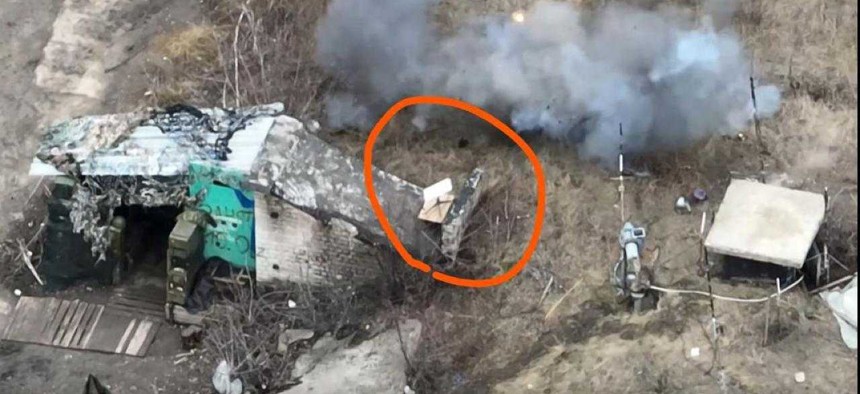
This image, annotated to highlight a Starlink terminal, was provided by a Ukrainian source who called it a screenshot of video from a Ukrainian drone participating in a strike on a Russian position inside Ukraine.
Russia is using SpaceX’s Starlink satellite devices in Ukraine, sources say
Elon Musk’s company, once hailed for aiding the besieged country, now appears to be helping its invaders as well.
Russian forces appear to be using SpaceX’s Starlink communications service inside Ukraine, suggesting that a company celebrated for helping the defenders is now also aiding the invaders.
Ukrainian troops first detected Russia’s frontline use of the satellite-connected devices several months ago, according to one Ukrainian source. A second Ukrainian source confirmed the use of Starlink, and added that its usage appeared to be increasing. Both sources were granted anonymity to discuss topics that they were not authorized to discuss.
Right now, Russian forces appear to be using tens of Starlink terminals across the long front, the first Ukrainian source said.
“When they have hundreds, it’ll be hard for us to live,” the first Ukrainian source said.
Russia’s use of Starlink compounds the problems faced by the Ukrainian military, which is already severely short of munitions. Ukrainian artillery units, for example, are firing around 2,000 shells per day, barely a fifth as many as their Russian counterparts.
Reports that Russian forces were using the Starlink service within Ukraine first appeared in Ukrainian media, citing social-media posts. Prominent Russian volunteer groups supporting the Russian invasion have also shown off Starlink terminals purchased for army units.
Pentagon spokesperson Jeff Jurgensen said U.S. officials are aware of the reports, but referred questions to “our Ukrainian partners for any current operational information regarding satellite communications activities of this kind.”
In a Feb. 8 tweet, SpaceX officials said the company “does not do business of any kind with the Russian Government or its military. Starlink is not active in Russia, meaning service will not work in that country. SpaceX has never sold or marketed Starlink in Russia, nor has it shipped equipment to locations in Russia.”
Multiple Russian companies advertise Starlinks for sale, including iMiele.ru and DJIRussia.
“If Russian stores are claiming to sell Starlink for service in that country, they are scamming their customers,” the tweet said.
But Russians can easily acquire Starlinks from abroad and then bring them back to distribute to their forces, the second Ukrainian source noted.
“It’s purchased through third parties,” the source said. “I’m amazed they didn’t do this sooner.”
SpaceX’s tweet did not directly address reports that Russian forces are using Starlink’s services within Ukraine.
It did say, “If SpaceX obtains knowledge that a Starlink terminal is being used by a sanctioned or unauthorized party, we investigate the claim and take actions to deactivate the terminal if confirmed.”
SpaceX is capable of preventing the use of Starlink devices in Russian-occupied territory. According to a biography of SpaceX founder Elon Musk, he refused a request by Ukraine to enable Starlink access in Russian-occupied Crimea to enable a Ukrainian attack.
However, Russian troops may be obscuring their use of Starlink to SpaceX, according to Bryan Clark, a senior fellow at the Hudson Institute.
Russia could simply “provide a false GPS signal to the Starlink terminal so it thinks the user is in Ukrainian-held territory,” Clark said. Clark also supported the idea that Ukraine could tell if Russia was using Starlink, as the terminals’ signals can be identified with signals intelligence equipment.
SpaceX may also be hesitant to tightly police the location of Starlinks, said Todd Humphreys, a professor at the University of Texas at Austin. With Ukrainian forces at times pressing attacks against Russia, SpaceX may “fear that a mistake in defining the front line could leave Ukraine without Starlink coverage,” he said.
The Starlink service gained prominence as a key element of Ukraine’s stout response to Russia’s full-scale invasion. SpaceX has provided thousands of the Starlink devices to Ukraine through company donations, U.S. military- funded transfers, and individual purchases by Ukrainian volunteers.
The devices allow frontline troops to set up high-bandwidth, mobile communications networks for use in operations centers and to coordinate artillery strikes, among other tasks. Ukraine’s use of Starlink and linked devices like drones is a “black swan,” event, one drone operator said last year amid Ukraine’s defense of the eastern Ukrainian city of Bakhmut.
The U.S. military also increasingly uses Starlink devices, as seen in recent exercises at the National Training Center in California. Space Command in September awarded a $70 million task order to SpaceX for Starshield, a military-oriented version of Starlink.
Commercially available versions of Starlink, such as those used in Ukraine, retail for as little as $599 for hardware and $120 for a monthly subscription.
Audrey Decker contributed to this report.



